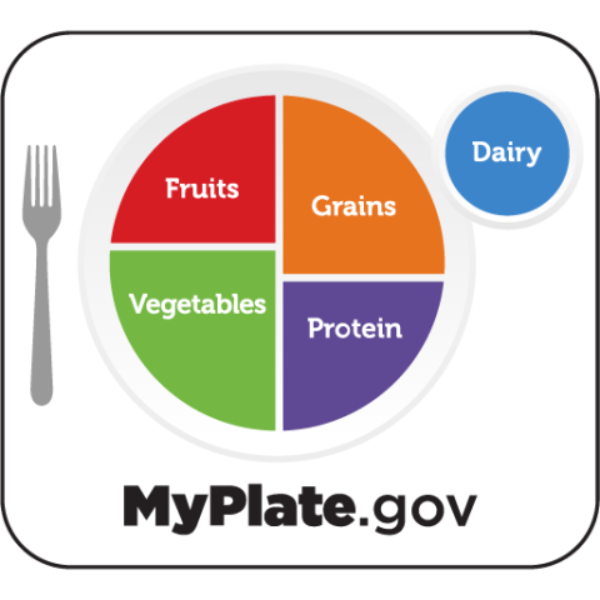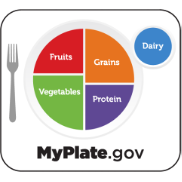
MyPlate Nutrition Basics
August 6, 2025 - Mallori Adragna
What is MyPlate?
Eating well can be simple, that is the idea behind MyPlate, a visual guide developed in 2011 by the United States Department of Agriculture (USDA) to replace the Food Pyramid. The purpose of MyPlate is to offer a simple, easy guide to help you build healthy, balanced meals. Designed with the Dietary Guidelines for Americans in mind, MyPlate helps people of all ages understand what and how much to eat for better health.
MyPlate is a colorful graphic shaped like a dinner plate. It is divided into five different sections to represent the essential food groups: fruits, vegetables, grains, protein, and dairy. Each section shows the proportion of your plate that should come from each group, encouraging balance and variety. The key message is simple: fill half your plate with fruits and vegetables and divide the other half between grains and protein, with a side of dairy. This easy-to-follow guide promotes a healthy way of eating that can fit into many different lifestyles and cultural traditions.

The Five Food Groups
Fruits
Fruits offer natural sweetness, fiber, and many important micronutrients to meals. Nutrients like vitamin C and potassium are plentiful in fruits and many people do not consume enough of them. MyPlate recommends focusing on whole fruits – fresh, frozen, canned, or dried – more than fruit juice. This is because whole fruit adds the most fiber and avoids added sugar.
Vegetables
Vegetables should fill half your plate (along with fruits) because they provide vitamins, minerals, and fiber. Aim to eat a variety – dark green, red/orange, starchy, and legumes (beans and peas) – throughout the week.
Grains
Grains are important for energy as they provide carbohydrates, as well as fiber and other nutrients if you choose whole grains. Sources include bread, rice, oats, pasta, and cereals. MyPlate recommends making at least half of your grains whole grains, like brown rice, quinoa, and whole wheat bread.
Protein
Protein is necessary for building and repairing your body’s tissues. MyPlate’s protein section includes animal and plant-based protein sources like meat, poultry, seafood, eggs, nuts, seeds, lentils, soy products, beans, and peas. Notice beans and peas are legumes which are considered vegetables too! MyPlate recommends eating a variety of lean or low-fat protein foods to get more nutrients and healthy fats.
Dairy
Dairy is part of the five essential food groups because it provides calcium and vitamin D, both of which are important for bone health. Foods that fall within this category include milk, yogurt, cheese, and fortified non-dairy alternatives. MyPlate only considers high calcium and low-fat or fat-free sources as counting towards this food group.
Tips for Using MyPlate
Here are a few practical tips to help you apply MyPlate to your daily meals:
- Watch your portion sizes. Remember MyPlate is based on a 9-inch plate!
- Focus on water or low-fat milk as beverages rather than sugary drinks.
- Fill half your plate with fruits and vegetables at meals and focus on variety (vary your colors).
- Choose low-fat or fat-free dairy options like low-fat or Greek yogurt and skim milk or fortified soy products.
- Read food labels to be sure you are making the healthy choice, limit added sugar, sodium, and saturated fat, and check for products made with 100% whole grains.
Conclusion
MyPlate is an approachable guide to healthy eating because it is not a diet and it’s not one-size-fits-all. It focuses on food groups and therefore it can be adapted to other cultures, individual preferences, and lifestyles. It allows everyone to adopt healthy habits and learn to build well-balanced meals that ensure nutrient recommendations are met.
Resources
Visit the MyPlate.gov website for more information and additional tools and resources. The website includes activities to determine how much you need of each food group based on age and sex, so your plate can be tailored to YOU. There are additional materials for printing, shopping, video aids, and tip sheets! Lastly, there is a MyPlate App for easy tracking and goal setting.



 Print
Print Email
Email





